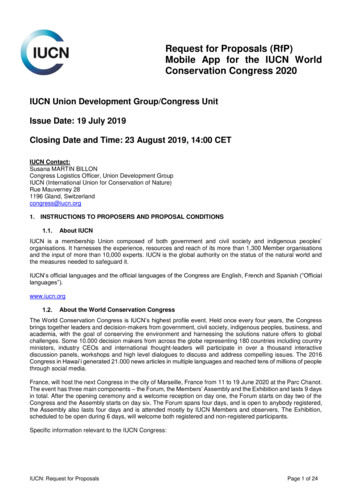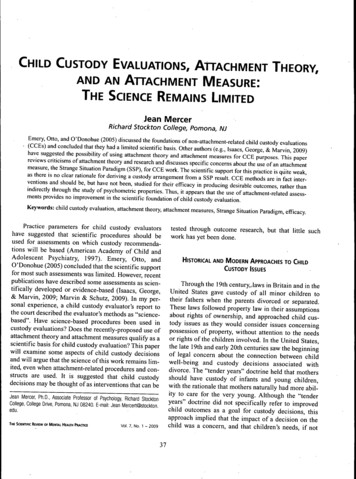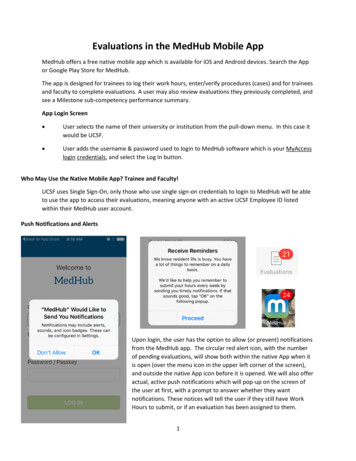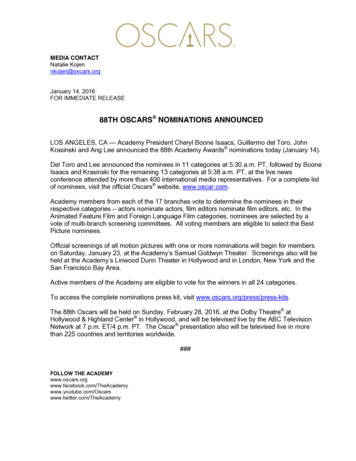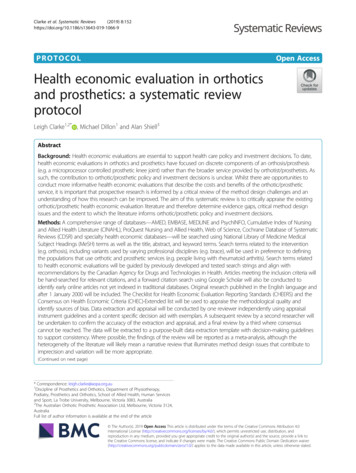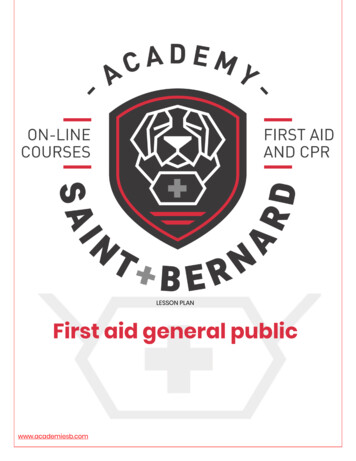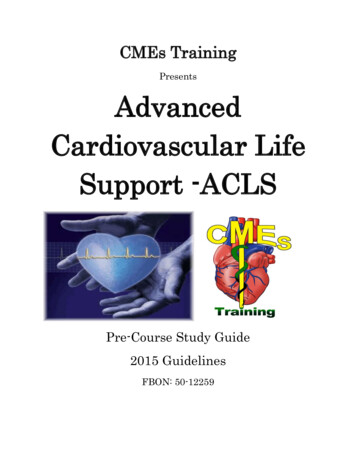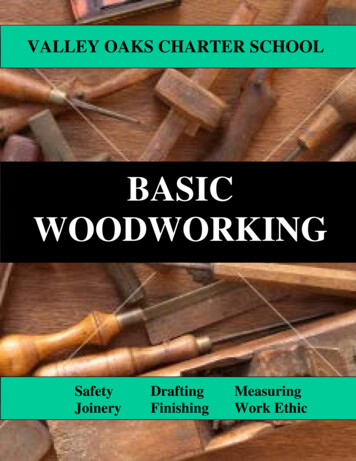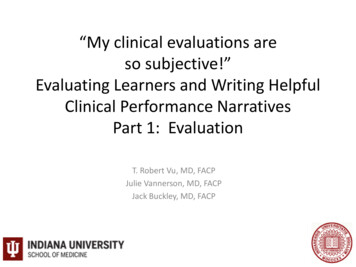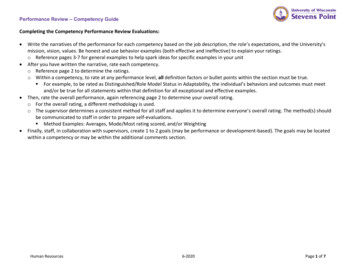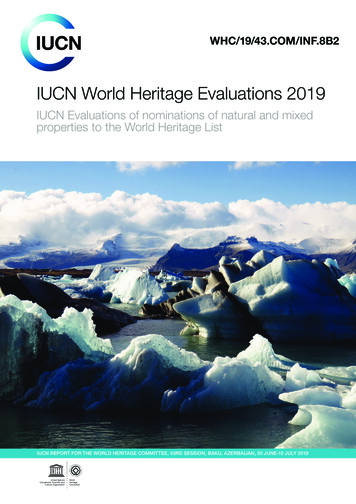
Transcription
WHC/19/43.COM/INF.8B2IUCN World Heritage Evaluations 2019IUCN Evaluations of nominations of natural and mixedproperties to the World Heritage ListIUCN REPORT FOR THE WORLD HERITAGE COMMITTEE, 43rd SESSION, Baku, Azerbaijan, 30 JUNE-10 JULY 2019
Cover photo:Vatnajökull National Park - dynamic nature of fire and ice, Iceland IUCN / Bastian Bertzky
IUCN Evaluations of Nominations of Natural andMixed Properties to the World Heritage ListTable of ContentsExecutive summary tableAlphabetical index, IUCN field evaluators, IUCN Red List of threatened speciesIntroductionA. Natural PropertiesA1.A2.New Nominations of Natural PropertiesAsia / PacificChina – Migratory Bird Sanctuaries along the Coast of Yellow Sea – Bohai-Gulf of China (Phase I)Iran (Islamic Republic of) – Hyrcanian Forests317Europe / North AmericaFrance – French Austral Lands and SeasIceland – Vatnajökull National Park - dynamic nature of fire and iceMonaco / Italy / France – Alpi del Mediterraneo – Alpes de la MéditerranéeTurkey – Kızılırmak Delta Wetland and Bird Sanctuary29415365Referred Nominations of Natural PropertiesAsia / PacificThailand – Kaeng Krachan Forest ComplexA3.Page n See document WHC/19/43.COM/INF.8B2.ADDMinor Boundary Modifications of Natural PropertiesEurope / North AmericaDenmark – Ilulissat IcefjordSee document WHC/19/43.COM/INF.8B2.ADDLatin America / CaribbeanBrazil – Cerrado Protected Areas: Chapada dos Veadeiros and Emas National ParksSee document WHC/19/43.COM/INF.8B2.ADDB. Mixed PropertiesB1.Page n New Nominations of Mixed PropertiesEurope / North AmericaAlbania – Natural and Cultural Heritage of the Ohrid region(extension of “Natural and Cultural Heritage of the Ohrid region”, the Republic of North Macedonia)77Latin America / CaribbeanBrazil – Paraty Culture and Biodiversity87
C. Cultural PropertiesC1.Page n New Nominations of Cultural LandscapesAsia / PacificAustralia – Budj Bim Cultural Landscape101Europe / North AmericaCanada – Writing-on-Stone / Áísínai’piSpain – Risco Caido and the Sacred mountains of Gran Canaria Cultural LandscapeSpain – Priorat-Montsant-Siurana, mosaïque méditerranéenne, paysage culturel agricole105109113Latin America / CaribbeanJamaica – Sunken City of Port Royal – A Relict and Continuing Cultural Landscape117DISCLAIMERThe designation of geographical entities in this book, and the presentation of the material, do not imply the expressionof any opinion whatsoever on the part of IUCN concerning the legal status of any country, territory, or area, or of itsauthorities, or concerning the delimitation of its frontiers or boundaries.
EXECUTIVE SUMMARY TABLE OF IUCN EVALUATIONS TO THE WORLD HERITAGE COMMITTEEOUTSTANDING UNIVERSAL VALUEMeets protection andmanagementrequirements13778, 132.4103-107Further mission requiredIUCN tectionstatus78, 98Justificationof serialapproach99-102Threatsaddressed78, 35Criterion (x)Buffer zone /Protection insurroundingarreaMeets conditions of integrityManagementParagraphs of the OperationalGuidelines for theImplementation of the WorldHeritage ConventionMigratory BirdSanctuaries along theChinaCoast of Yellow SeaBohai, Gulf of China(Phase I) (1606)NoteCriterion (ix)Name of theproperty(ID number)Criterion (viii)StatePartyCriterion (vii)Meets one or more natural criteriaIran (IslamicRepublic of)Hyrcanian anceFrench Austral Landsand Seas (1603)yes̶yesyesyesyesyesyesyesyesnoIVatnajökull NationalPark - dynamic nature offire and nonopartnononopartnoNIcelandMonaco / Italy // FranceAlpi del Mediterraneo –Alpes de laMéditerranée(1598)̶
OUTSTANDING UNIVERSAL VALUE78, 9813778, 132.4103-107Further mission requiredIUCN nstatus99-102Justificationof serialapproach78, erion (x)7778,108-118,132.4,135Criterion (ix)Buffer zone /Protection insurroundingarreaParagraphs of the OperationalGuidelines for theImplementation of the WorldHeritage ConventionCriterion (viii)NoteCriterion (vii)Name of theproperty(ID number)StatePartyMeets protection andmanagementrequirementsMeets conditions of integrityManagementMeets one or more natural criteriaTurkeyKızılırmak DeltaWetland and BirdSanctuary(1601)AlbaniaNatural and CulturalHeritage of theOhrid region(99 Quater)ExtensionMixed siteyes̶̶̶yesyesno̶yesnopartnoIBrazilParaty Culture andBiodiversity(1308 Rev)Mixed sideno̶̶yesyesyespartyesyesyespartnoIItalySila partially metnot metnot applicableINRDinscribe / approvenon inscribe / approvereferdefer
ALPHABETICAL INDEXState PartyAlbaniaBrazilID No.99 Quater1308 RevChina1606FranceIcelandIran (IslamicRepublic of)Monaco / Italy /FranceTurkey16031604PropertyNatural and Cultural Heritage of the Ohrid regionParaty Culture and BiodiversityMigratory Bird Sanctuaries along the Coast of Yellow Sea-Bohai, Gulf ofChina (Phase I)French Austral Lands and SeasVatnajökull National Park - dynamic nature of fire and icePage77871584Hyrcanian Forests171598Alpi del Mediterraneo – Alpes de la Méditerranée531601Kızılırmak Delta Wetland and Bird Sanctuary6532941IUCN FIELD EVALUATORSSiteNatural and Cultural Heritage of the Ohrid regionParaty Culture and BiodiversityMigratory Bird Sanctuaries along the Coast of Yellow SeaBohai, Gulf of China (Phase I)French Austral Lands and SeasAlpi del Mediterraneo – Alpes de la MéditerranéeVatnajökull National Park - dynamic nature of fire and iceHyrcanian ForestsKızılırmak Delta Wetland and Bird SanctuaryNameBrent A. MitchellDoris CorderoSonali Ghosh and Tilman JaegerWendy Strahm and Anjara SalomaJosephine Langley and José BrilhaBastian Bertzky and Dan TormeySusanna Lindeman and Hervé LethierNaomi DoakIt should be noted that the IUCN field evaluators are part of a broader evaluation approach detailed in the introductionof this report.THE IUCN RED LIST OF THREATENED SPECIESThroughout the report we have indicated the conservation status of each species as recorded in the IUCN Red List ofThreatened Species at the time of the evaluation; for more information please visit http://www.iucnredlist.org.Keys to abbreviations:CR: Critically EndangeredEN: EndangeredVU: VulnerableNT: Near threatenedLC: Least ConcernNE: Not Evaluated
THE WORLD HERITAGE CONVENTIONIUCN TECHNICAL EVALUATION REPORT OF WORLD HERITAGE NOMINATIONSMAY 20191. INTRODUCTIONThis technical evaluation report of natural and mixedproperties nominated for inclusion on the WorldHeritage List has been conducted by the WorldHeritage Programme of IUCN (International Union forConservation of Nature). The World HeritageProgramme co-ordinates IUCN’s input to the WorldHeritage Convention in close cooperation with theIUCN Global Protected Areas Programme (GPAP) andother units of IUCN both at headquarters and in theregions. It also works particularly closely with IUCN’sWorld Commission on Protected Areas (WCPA), theworld’s leading expert network of protected areamanagers and specialists, with the IUCN SpeciesSurvival Commission (SSC) and other IUCNCommissions, as well as the many members andpartners of IUCN.IUCN’s evaluations are conducted according to theOperational Guidelines for the Implementation of theWorld Heritage Convention that the World HeritageCommittee has agreed, and which are the essentialframework for the application of the evaluationprocess. This framework was updated and revised in2015, and a revised process documented in Annex 6of the Operational Guidelines, following discussion bythe World Heritage Committee. In carrying out itsfunction under the World Heritage Convention, IUCNhas been guided by four principles:(i)ensuring the highest standards of quality control,institutional memory and consistency in relation totechnical evaluation, monitoring and otherassociated activities;(ii)increasing the use of specialist networks of IUCN,especially WCPA, but also other relevant IUCNCommissions and specialist partner networks;(iii) working in support of the UNESCO WorldHeritage Centre and States Parties to examinehow IUCN can creatively and effectively supportthe World Heritage Convention and individualproperties as “flagships” for conservation; and(iv) increasing the level of effective partnershipbetween IUCN and the World Heritage Centre,ICOMOS and ICCROM.Members of the expert network of WCPA carry out themajority of technical evaluation missions, supported byother specialists where appropriate. The WCPAnetwork now totals more than 2000 members,protected area managers and specialists from over140 countries. In addition, the World HeritageProgramme calls on relevant experts from IUCN’sIUCN Evaluation Report – May ntal Law, Education and ,Economic and Social Policy); from international earthscience unions, non-governmental organizations andscientific contacts in universities and otherinternational agencies. This highlights the considerable“added value” from investing in the use of theextensive networks of IUCN and partner institutions.These networks allow for the increasing involvement ofregional natural heritage experts and broaden thecapacity of IUCN with regard to its work under theWorld Heritage Convention. Reports from fieldmissions and comments from a large number ofexternal reviewers are comprehensively examined bythe IUCN World Heritage Panel, as key inputs to eachevaluation. The IUCN World Heritage Programmeprepares the final technical evaluation reports, whichare presented in this document, and represent thecorporate position of IUCN on World Heritageevaluations. IUCN has also placed emphasis onproviding input and support to ICOMOS in relation tothose cultural landscapes which have important naturalvalues.IUCN has continued to extend its cooperation withICOMOS, including coordination in relation to theevaluation of mixed sites and cultural landscapes.IUCN and ICOMOS have also enhanced thecoordination of their panel processes as requested bythe World Heritage Committee. This cooperation wasreported at the 40th Session of the World HeritageCommittee, and will be discussed under Item 9B thisyear, where IUCN and ICOMOS exchanged andcoordinated their advice to the Committee, as alsonoted in the relevant specific reports.IUCN has endeavoured wherever possible to work inthe spirit of the Upstream Process, as will be debatedin the relevant items on the Committee’s agenda.2. EVALUATION PROCESSIn carrying out the technical evaluation of nominations,IUCN is guided by the Operational Guidelines,specifically Annex 6, which spells out the evaluationprocess. The evaluation process is carried out over theperiod of one year, from the receipt of nominations atIUCN in March and the submission of the IUCNevaluation report to the World Heritage Centre in April /May of the following year. The process involves thefollowing steps:i
1.External Review. The nomination is sent toindependent experts knowledgeable about theproperty or its natural values, including membersof WCPA, other IUCN specialist Commissionsand scientific networks or NGOs working in theregion. IUCN received over 90 external reviews inrelation to the properties examined in 2018 /2019.2.Field Mission. Missions involving one, orwherever possible two or more IUCN experts,evaluate the nominated property on the groundand discuss the nomination with the relevantnational and local authorities, local communities,NGOs and other stakeholders. IUCN endeavours,where possible, to ensure mission experts haveknowledge and experience in the relevant region.Missions usually take place between July andOctober. In the case of mixed properties andcertain cultural landscapes, missions are jointlyimplemented with ICOMOS.3.IUCN World Heritage Panel Review. The Panelintensively reviews the nomination dossiers, fieldmission reports, comments from externalreviewers and other relevant reference material,and provides its technical advice to IUCN onrecommendations for each nomination. A finalreport is prepared and forwarded to the WorldHeritage Centre in April / May for distribution tothe members of the World Heritage Committee.4.Comparative Analysis. IUCN commissions UNEnvironment WCMC to carry out a globalcomparative analysis for all properties nominatedunder the biodiversity criteria (ix) and (x) to astandard and publicly available IUCN / WCMCmethodology. Following inscription, datasheetsare compiled with WCMC.5.Communities. IUCN has enhanced its evaluationprocesses through the implementation of a seriesof measures to evaluate stakeholder and rightsholder engagement during the nominationprocess (see below for further details).6.Final Recommendations. IUCN presents, withthe support of images and maps, the results andrecommendations of its evaluation process to theWorld Heritage Committee at its annual session inJune or July, and responds to any questions. TheWorld Heritage Committee makes the finaldecision on whether or not to inscribe the propertyon the World Heritage List.It should be noted that IUCN has increasingly sought,over many years, to develop and maintain a dialoguewith the State Party throughout the evaluation processto allow the State Party every opportunity to supply allthe necessary information and to clarify any questionsor issues that may arise. IUCN is available to respondto questions at any time, however, there are threeoccasions on which IUCN may formally request furtherinformation from the State Party. These are:ii Before the field mission. IUCN sends the StateParty, usually directly to the person organizing themission in the host country, a briefing on themission, in many cases raising specific questionsand issues that should be discussed during themission. This allows the State Party to prepareproperly in advance; Directly after the field mission. Based ondiscussions during the field mission, IUCN maysend an official letter requesting supplementaryinformation before the IUCN World Heritage Panelmeets in December, to ensure that the Panel hasall the information necessary to make arecommendation on the nomination; and After the first meeting of the IUCN WorldHeritage Panel (December). IUCN continues itspractice of ongoing communication with thenominating State/s Party/ies following its Panelmeeting. In line with changes to Annex 6 of theOperational Guidelines, this communication nowcomprises an interim report to the Parties on thestatus of the evaluation, sent by the end ofJanuary. If the Panel finds that some questionsare still unanswered, or further issues need to beclarified, this letter may request supplementaryinformation by a specific deadline. That deadlinemust be adhered to strictly in order to allow IUCNto complete its evaluation. In view of theimportance of the requests for supplementaryinformation, IUCN seeks to complete these lettersat least one month before the requested deadlineof 31st January, and in the present cycle all butone nomination where the IUCN Panel hadquestions, these were sent before the end ofDecember 2018. It should be noted that in anumber of cases, the Panel may not haveadditional questions, but nevertheless dialogue isinvited in all cases.It is expected that supplementary information willbe in response to specific questions or issues andshouldnotincludecompletelyrevisednominations or substantial amounts of newinformation. It should be emphasized that whilstexchanges between evaluators and the StatesParties during the mission may provide valuablefeedback, they do not substitute for the formalrequests for supplementary information outlinedabove. IUCN has continued to promote additionaldialogue with States Parties on the conclusion ofits panel process, to allow for discussion of issuesthat have been identified and to allow more timeto prepare discussions at the World HeritageCommittee. This has involved face to facemeetings in Paris, and in IUCN’s offices inSwitzerland, and conference calls via Skype ordial-in conferences.In the technical evaluation of nominated properties,global biogeographic classification systems, such asUdvardy’s biogeographic provinces, and the TerrestrialEcoregion of the World (similarly, freshwater andmarine ecoregions of the world in respectiveenvironments), are used to identify and assessIUCN Evaluation Report – May 2019
comparable properties at the global level. Thesemethods make comparisons of natural properties moreobjective and provide a practical means of assessingsimilarity and contrasts at the global level. At the sametime, World Heritage properties are expected tocontain special features, habitats and faunistic orfloristic peculiarities that can also be compared on abroader biome basis. It is stressed that these systemsare used as a basis for comparison only and do notimply that World Heritage properties are to be selectedbased on these systems alone. In addition, globalconservation priority-setting schemes such as as.org/home), includingImportant Bird Areas, Alliance for Zero Extinction sites,and systems such as WWF’s Global 200 PriorityEcoregions, Conservation International’s BiodiversityHotspots and High Biodiversity Wilderness Areas,Birdlife International’s Endemic Bird Areas, andIUCN/WWF Centres of Plant Diversity, provide usefulguidance. IUCN in partnership with UN EnvironmentWCMC continues to explore the use of newcomparative analyses. The decisive principle is thatWorld Heritage properties are only exceptional areasof Outstanding Universal Value.The evaluation process is also aided by the publicationof a series of reference volumes and thematic studies.In early 2012, a resource manual on the preparation ofWorld Heritage nominations was published under jointlead authorship of IUCN and ICOMOS, and hasprovided further details on best practices, including thekey resources that are available to supportnominations. IUCN’s range of thematic studies and keyreferences that advise priorities on the World HeritageList are available at the following web resources.IUCN members adopted a specific resolution on thesematters at the IUCN World Conservation Congress in2012, which remains current, and this resolution(WCC-2012-Res-047-EN Implementation of the UnitedNations Declaration on the Rights of IndigenousPeoples in the context of the UNESCO World HeritageConvention) is available at the following /motions.IUCN has continued to implement a range of improvedpractices within its evaluation process in response tothese reviews and reflections, which are focused onthe inclusion of a specific section headed“Communities” within each evaluation report, to ensuretransparency and consistency of IUCN’s advice to theWorld Heritage Committee on this important issue.These measures include a standard screening form forall evaluation missions, additional consultation withnetworks specialised in this field, and an expertadvisor in the membership of the IUCN World HeritagePanel.In 2013, IUCN updated its format for field evaluationreports to include specific questions on communitiesand to clarify a range of questions and expectations onfeedback from evaluators to ensure consistency ofreports from field missions. This material is all publiclyavailableatthefollowingwebaddress:IUCN Evaluation Report – May ork/advisor-world-heritage/nominations.IUCN has also been actively supporting processesunder the mandate of the Ad Hoc Working Group(Decsion 42 COM 12A) which seek to reform thenomination processes within the frame of the WorldHeritage Convention and Operational Guidelines.IUCN welcomes this constructive dialogue to evolvethe working methods of the Convention and considersthe work of the Ad Hoc Working Group provides agood model for possible continued dialogue towardseffective new procedures for the evaluation process.IUCN has also actively contributed to the expertReflection meeting on reforming the World HeritageNomination Process, held in Tunis, 23-25 January2019.IUCN notes that reform of the evaluation process isconstrained fundamentally by the current calendar,and that many of the expectations of States Partiesregarding increases in dialogue and transparencyrequire more time to be provided for the evaluation,especially for nominations that are found to not meetrequirements of the Operational Guidelines. Given theinterlinkages between various processes, IUCNconsiders it essential that a fully integrated package ofreforms is agreed as a central priority, and continuedreflection on options and additional resources will berequired to enable it to be effective, equitable to StatesParties, and appropriate in supporting a balanced andrepresentative World Heritage List.3. THE IUCN WORLD HERITAGE PANELPurpose: The Panel advises IUCN on its work onWorld Heritage, particularly in relation to the evaluationof World Heritage nominations. The Panel normallymeets face to face once a year for a week inDecember. Depending on the progress made withevaluations, and the requirement for follow up action, asecond meeting or conference call the following Marchmay be required. Additionally, the Panel operates byemail and/or conference call, as required.Functions: A core role of the Panel is to provide atechnical peer review process for the consideration ofnominations, leading to the formal adoption of adviceto IUCN on the recommendations it should make to theWorld Heritage Committee. In doing this, the Panelcritically examines each available nominationdocument, the field mission report, the UNEnvironment WCMC Comparative Analysis, commentsfrom external reviewers and other material. Thismaterial is then used to help prepare IUCN’s advice,including IUCN recommendations relating to inscriptionunder specified criteria, to the World HeritageCommittee (and, in the case of some culturallandscapes, advice to ICOMOS). The Panel may alsoadvise IUCN on other matters concerning WorldHeritage, including the State of Conservation of WorldHeritage properties and on policy matters relating tothe Convention. Though it takes account of the policycontext of IUCN’s work under the Convention, itsprimary role is to deliver independent, high qualityiii
scientific and technical advice to IUCN, which has thefinal responsibility for corporate recommendationsmade to the World Heritage Committee. Panelmembers agree to a code of conduct, which ensuresethical behaviour and avoids any conflict of interest.Membership: Membership of the Panel is at theinvitation of the IUCN Director General (or DeputyDirector General under delegated authority) throughthe Director of the World Heritage Programme. Themembers of the Panel comprise IUCN staff withresponsibility for IUCN’s World Heritage work, otherrelevant IUCN staff, Commission members andexternal experts selected for their high level ofexperience with the World Heritage Convention. Themembership of the Panel comprises: The Director, IUCN World Heritage Programme(Chair – non-voting)At least one and a maximum of two staff of theIUCN Global Protected Areas ProgrammeOne Senior Advisor appointed by the IUCNDirector General or delegate to advise theorganisation on World HeritageThe IUCN World Commission on Protected Areas(WCPA) Vice Chair for World HeritageA representative of the IUCN Species SurvivalCommission(SSC)appointedonrecommendation of the Chair, SSCUp to seven technical advisors, invited by IUCNand serving in a personal capacity, withrecognised leading expertise and knowledgerelevant to IUCN’s work on World Heritage,including particular thematic and/or regionalperspectivesAs of 2017 / 2018 one position for a specialist ingeological heritage, appointed by IUCN followingconsultation with the International Union ofGeological Sciences (IUGS) and the UNESCOEarth Sciences has been introduced.In the course of 2016, and as previously agreedfollowing the recommendation of the Committee’s AdHoc Working Group, IUCN introduced a fixed term forPanel members (four years renewable once) and aninternal application process, open to IUCNCommission members and IUCN members, to fillvacancies for technical advisors when they arise.The Panel’s preparations and its meetings arefacilitated through the work of the World HeritageEvaluations and Operations Officer. Information on themembers of the IUCN World Heritage Panel, togetherwith its Terms of Reference (TOR) and the formats forIUCN documentation related to the evaluation rld-heritage/iucn-world-heritage-panel.A senior manager in IUCN (currently the IUCN GlobalDirector, Biodiversity Conservation) is delegated by theDirector General to provide oversight at senior level onWorld Heritage, including with the responsibility toensure that the Panel functions within its TOR andmandate. This senior manager is not a member of thePanel, but is briefed during the Panel meeting on thePanel’s conclusions. The Panel meeting may also beivattended by other IUCN staff, Commission members(including the WCPA Chair) and external experts forspecific items at the invitation of the Chair.4. EVALUATION REPORTSEach technical evaluation report presents a concisesummary of the nominated property, a comparisonwith other similar properties, a review of protection,management and integrity issues and concludes withthe assessment of the applicability of the criteria and aclear recommendation to the World HeritageCommittee. IUCN also submits separately to the WorldHeritage Centre its recommendation in the form of adraft decision, and a draft Statement of OutstandingUniversal Value for all properties it recommends forinscription. In addition, IUCN carries out field missionsand/or external reviews for cultural landscapescontaining important natural values, and provides itscomments to ICOMOS. This report contains a shortsummary of these comments on each culturallandscape nomination reviewed.5. NOMINATIONS EXAMINED IN 2018 / 2019Nomination dossiers and minor boundary modificationsexamined by IUCN in the 2018 / 2019 cycle included: 7 natural property nominations;2 mixed property nomination, where a jointmission was undertaken with ICOMOS, including1 extension;1 referred nomination;5 cultural landscape nominations (all newnominations); all 5 were commented on by IUCNbased on internal and external desktop reviews;2 minor boundary modifications.6. COLLABORATION WITHEARTH SCIENCE UNIONSINTERNATIONALIUCN implements its consideration of earth sciencevalues within the World Heritage Convention through aglobal thematic study on Geological Heritagepublished in 2005. In addition, collaborationagreements with IUGS and the InternationalAssociation of Geomorphologists (IAG) focus onstrengthening the evaluation process by providingaccess to the global networks of earth scientistscoordinated through IUGS and IAG. IUCN would like torecord its gratitude to IUGS and IAG for theirwillingness to provide support to IUCN in fulfilling itsadvisory role to the World Heritage Convention.7. RECOMMENDATIONSHERITAGE COMMITTEETOTHEWORLDIn the 2018 / 2019 cycle, IUCN has sought to ensurethat States Parties have the opportunity to provide allthe necessary information on their nominatedproperties through the process outlined in section 2above. As per the provisions of the OperationalIUCN Evaluation Report – May 2019
Guidelines, and Decision 30 COM 13 of the WorldHeritage Committee (Vilnius, 2006), IUCN has nottaken into consideration or included any informationsubmitted by States Parties after 28 February 2019, asevidenced by the postmark. IUCN has previouslynoted a number of points for improvement in theevaluation process, and especially to clarify thetimelines involved.Acknowledgements for advice received are due to theexternal evaluators and reviewers, many of them fromIUCN’s members, Commissions and Networks, andnumerous IUCN staff at Headquarters and in IUCN’sRegional and Country Offices. Many others contributedinputs during field missions. This support isacknowledged with deep gratitude.8. ACKNOWLEDGEMENTSAs in previous years, this report is a group product towhich a large number of people have contributed.IUCN Evaluation Report – May 2019v
Figure 1: IUCN Evaluation ProcessviIUCN Evaluation Report – May 2019
A. NATURAL PROPERTIESA1. NEW NOMINATIONS OF NATURAL PROPERTIES
ASIA / PACIFICMIGRATORY BIRD SANCTUARIES ALONG THE COAST OFYELLOW SEA-BOHAI GULF OF CHINA (PHASE I)CHINASpoon-billed Sandpiper (Calidris pygmaea) habitat, Tiaozini IUCN / Sonali Ghosh
China – Migratory Bird Sanctuaries along the Coast of Yellow Sea-Bohai Gulf of China (Phase I)WORLD HERITAGE NOMINATION – IUCN TECHNICAL EVALUATIONMIGRATORY BIRD SANCTUARIES ALONG THE COAST OF YELLOW SEABOHAI-GULF OF CHINA (PHASE I) (CHINA) – ID N 1606IUCN RECOMMENDATION TO WORLD HERITAGE COMMITTEE: To defer the nominated property under naturalcriteria.Key paragraphs of Operational Guidelines:Paragraph 77: Nominated property has potential to meet World Heritage criteria.Paragraph 78: Nominated property does not currently meet integrity, protection and management requirements.1. DOCUMENTATIONa) Date nomination received by IUCN: 25 March 2018.b) Additional information officially requested fromand provided by the State Party: Following the IUCNWorld Heritage Panel a progress report was sent to theState Party on 20 December 2018. This letter advised onthe status of the evaluation process and soughtresponses/clarifications on a range of issues includingthe assessment of the relative significance of the valuesrepresented in the nominated property in relation to thevalue of the potential 14 components remaining to benominated in the future; the status, plans and timelin
the IUCN World Heritage Panel, as key inputs to each evaluation. The IUCN World Heritage Programme prepares the final technical evaluation reports, which are presented in this document, and represent the corporate position of IUCN on World Heritage evaluations. IUCN has also placed emphasis on providing input and support to ICOMOS in relation to
